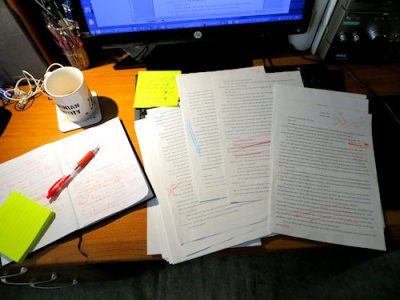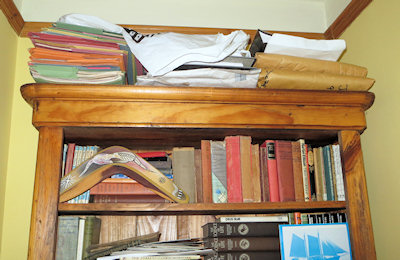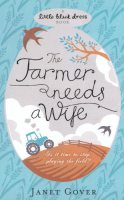I’ve been in my editing cave for the past three weeks. It’s sort of like a bear being in their hibernation cave… except bears tend to lose weight during hibernation. There is a shared reputation for being cranky when disturbed though…
Writing The End on the last page of a manuscript is NOT the end. It’s far from it. Every writer’s process is different. There’s no right way or wrong way, there’s just the way that works for the writer. So I thought I’d give you a bit of a look at my editing process… which explains my absence from Twitter and Facebook and the kitchen. It doesn’t explain why my office is messy though – my office is always messy.

Editing needs both old and new technology … and many cups of tea.
I tend to do a lot of editing as I go, so my first draft of the book is usually in fairly good shape structurally. But by the time I get to the end, there’s a lot I know about my characters and themes that I didn’t know when I started.
The first edit is just me and the computer. I read the book through from page one to The End, making changes as I go. This is to make sure the story works. This is the point at which I might change a plot point or move a scene. I look carefully at my characters during edit 1. I may change their speech or behaviour at the beginning of the book to match the people I now know them to be. I may add imagery. I sometimes find that I am adding an action or some dialogue because I need this to background something that I put in later in the book.
Edit two – I print out the whole book. I sometimes think this is a bit of displacement activity because it takes me the best part of the day to print it out, punch holes in the pages and put it into a ring binder.
Then I give myself a day or two off (if I can). I read something else just to clear my head of my own book. They I read my book as a reader – not as a writer. However, I do something I never do to another book – I scribble all over it. Coloured pencils are important here and post it notes. The coloured pencils are to the words or sentences I don’t like – those I have to rework. The post it notes are for plot or character points that still don’t work.
Then it’s back to the computer to fix those.

The packages on top opf my bookcase hold the much scribbled on editing printouts of my books. I’m not sure why I am keeping them… I just can’t throw them away.
After I’ve done that, the book goes to my beta reader. For those who don’t know, a beta reader is a sort of test driver for books. The beta reader is someone you trust who will give an honest opinion about what works and what doesn’t in the book. I have one. Some people have two or three. My beta reader isn’t afraid to tell me it’s not perfect – or to write Cliché Hell in the margins of the manuscript. That’s the job.
So then it’s back to the computer for another round of edits which will this time include some spelling and punctuation.
Then I combine all my documents (I write each chapter in a separate document) into one big document. Run a final spell check across the whole thing. I also use the Find tool to check on my crutch words – the words I know I overuse. I will then delete many occurrences of the words ‘just’ and ‘really’.
At this point – it’s ready to go. Hitting send is a traumatic moment… but has to be done and leads to the next round of edits… the publishers edits.
The publisher assigns and editor who send the dreaded revision letter which always starts… ‘This is a wonderful book and your readers will love it…. BUT …’
The first round of publishers edits usually involved changes to character, plot and even structure. The second round will look at the writing – words and phrases that could be improved. Then we have copy edits – which is all about spelling, punctuation and those dratted semi-colons. Does this sound familiar?
Then the publisher does what publishers do – and the next thing I see are page proofs. So one again I read the whole book very very carefully, looking for any sneaky little errors that have slipped through the net or, eeek, errors made when the final printing file is prepared.
And some time after that (sometimes a long time) – a box arrives on my doorstep with books in it.
Many years ago, when I first started this writing journey, I heard an established writer say they had never read one of their books after it was published. I was horrified. After all that work, how could she not read her own book? Now I know. I have never read one of my books after it has been published.

My very first book – maybe one day I willread it again.
Why?
By the time it’s published, I have read it so many times, that I just don’t want to read it again. I know how it ends.
I recently thought about going back and reading my very first book. But I didn’t do it. Like everything else, I think we become better writers as we go along, and I am afraid that all I will see in that first book are the flaws, and I’ll want to edit it just one more time.
And right now, I need to get out of my editing cave and back into the sunshine, because any day now, I’m going to decide it’s time to start the next book. If the meantime – for a more emotional view of my editing cave, pop on over to my website and blog – but be prepared to go awww! There is much cuteness there.

Interesting I can understand why you wouldn’t read your books after publishing.
LikeLiked by 1 person
Thanks Nancy – It’s nice that not everyone thinks its strange 🙂
LikeLike
Reblogged this on Chicklit Sisters and commented:
All about editing. Janet Gover’s great post 😀
LikeLiked by 1 person
Great post Janet. Lorraine and I have just come out of our cave recently. Eyes still blinking in the light 🙂
LikeLiked by 1 person
I like to have a printed version to work on. I hink I notice more errors when reading from a printed page. It’s also easier to read bits aloud which I find is a good way to catch unwieldy sentence constructions.
LikeLiked by 1 person
I also read things aloud to help with the edits. it’s interesting how much alike our processes are.
LikeLike
Well, this resonates! I’m just like you, Janet, in that I get to know my characters much better during the many months I spend with them as I write the first draft. I also edit as I go, but it’s never enough, is it? The process is endless – and there comes a point you have to make yourself stop, because it’s never perfect, is it? (And never will be, however many edits you do.) There’s a danger you can over edit and lose the spontaneity that makes it shine.
Thanks for sharing – it’s good to know that writers have a lot in common!
LikeLiked by 1 person
I guess we all have the same goal Jenny – to give our readers the best book we can. For me, letting go can be hard, but you are right… at some point we have to send out babies out into the work and let them fly.
LikeLiked by 1 person
Pingback: The editing cave – Take Five Authors – Jenny Harper Author
A really interesting post, Janet. My editing routine has similarities to yours but I don’t print the book (for me). I have tried it but felt frustrated by being unable to fix things the instant I read them. I do print for one of my beta readers, though.
LikeLiked by 2 people
I think my printing run goes back to my days as a TV journalist. I would always have a print out of my story to take into the audio booth to record the voice track, and I would give it a final check as I did that. I also used to print my short stories for a final check. I think its a way of tricking my brain into looking at it with new eyes.
LikeLike